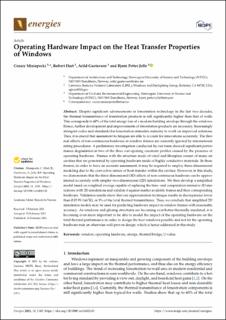| dc.contributor.author | Misiopecki, Cezary | |
| dc.contributor.author | Hart, Robert | |
| dc.contributor.author | Gustavsen, Arild | |
| dc.contributor.author | Jelle, Bjørn Petter | |
| dc.date.accessioned | 2021-02-22T08:34:35Z | |
| dc.date.available | 2021-02-22T08:34:35Z | |
| dc.date.created | 2021-02-20T05:39:31Z | |
| dc.date.issued | 2021 | |
| dc.identifier.citation | Energies. 2021, 14 (4), 1-12. | en_US |
| dc.identifier.issn | 1996-1073 | |
| dc.identifier.uri | https://hdl.handle.net/11250/2729368 | |
| dc.description.abstract | Despite significant advancements in fenestration technology in the last two decades, the thermal transmittance of fenestration products is still significantly higher than that of walls. This corresponds to 60% of the total energy loss of a modern building envelope through the windows. Hence, further development and improvements of fenestration products are necessary. Increasingly stringent codes and standards for fenestration stimulate industry to work on improved solutions. Thus, it is crucial that assessment techniques are able to account for innovations accurately. The thermal effects of non-continuous hardware in window frames are currently ignored by international rating procedures. A preliminary investigation conducted by our team showed significant performance degradation in two of the three out-opening casement profiles caused by the presence of operating hardware. Frames with the structure made of vinyl and fiberglass consist of many air cavities that are penetrated by operating hardware made of highly conductive materials. In these frames, in order to have an accurate assessment, it may be required to employ three-dimensional modeling due to the convective nature of heat transfer within the cavities. However, in this study, we demonstrate that the three-dimensional (3D) effects of non-continuous hardware can be approximated accurately with simpler two-dimensional (2D) simulations. We then develop a simplified model based on weighted average capable of replacing the time- and computation-intensive 3D simulations with 2D simulations and validate it against market available frames and their corresponding hardware. Validation results show that our approximation technique results in discrepancies lower than 0.05 W/(m2K), or 3% of the total thermal transmittance. Thus, we conclude that simplified 2D simulation models may be used for predicting hardware impact in window frames with reasonable accuracy. As windows and glazing structures are becoming ever better thermally insulated, it is becoming even more important to be able to model the impact of the operating hardware on the total thermal performance in order to design the best windows possible and not let the operating hardware ruin an otherwise well-proven design, which is hence addressed in this study. | en_US |
| dc.language.iso | eng | en_US |
| dc.publisher | MDPI | en_US |
| dc.rights | Navngivelse 4.0 Internasjonal | * |
| dc.rights.uri | http://creativecommons.org/licenses/by/4.0/deed.no | * |
| dc.title | Operating Hardware Impact on the Heat Transfer Properties of Windows | en_US |
| dc.type | Peer reviewed | en_US |
| dc.type | Journal article | en_US |
| dc.description.version | publishedVersion | en_US |
| dc.source.pagenumber | 1-12 | en_US |
| dc.source.volume | 14 | en_US |
| dc.source.journal | Energies | en_US |
| dc.source.issue | 4 | en_US |
| dc.identifier.cristin | 1891967 | |
| dc.relation.project | Norges forskningsråd: 207551 | en_US |
| dc.description.localcode | This is an open access article distributed under the Creative Commons Attribution License which permits unrestricted use, distribution, and reproduction in any medium, provided the original work is properly cited | en_US |
| cristin.ispublished | true | |
| cristin.fulltext | original | |
| cristin.qualitycode | 1 | |

